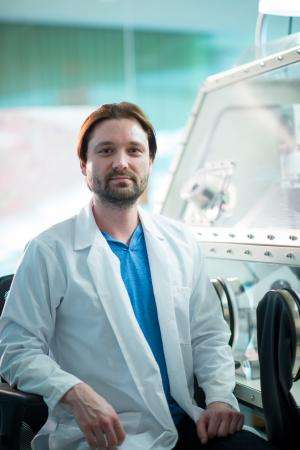Scientists find way to 'keep the lights on' for cell self-renewal

One remarkable quality of pluripotent stem cells is they are immortal in the lab, able to divide and grow indefinitely under the right conditions. It turns out this ability also may exist further down the development path, with the workhorse progenitor cells responsible for creating specific tissues.
A team from the Morgridge Institute for Research regenerative biology group, led by stem cell pioneer James Thomson, discovered a way to impose an immortal-like state on mouse progenitor cells responsible for producing blood and vascular tissue. By regulating a small number of genes, the cells became "trapped" in a self-renewing state and capable of producing functional endothelial, blood and smooth muscle cells.
The finding, to be published in the December 9, 2014 issue of Stem Cell Reports, points to a potential new approach to developing cells in the lab environment for use in drug screening, therapies and as a basic research tool.
"The biggest takeaway for me is the ability to arrest development of these cells," says David Vereide, a Morgridge fellow in regenerative biology and lead author on the paper. "Normally, these cells are ephemeral and get used up while differentiating into specific cell types, but we found a way to interrupt that."
During development, blood and vascular cells are thought to originate from a progenitor cell known as a hemangioblast. This research project identified and imposed six transcription factors on the cells that allowed hemangioblasts to keep proliferating over multiple generations. Transcription factors are proteins that regulate which genes get turned on or off in a genome.
In this case, the transcription factors act to "keep the lights on" in these cellular factories that kept them dividing and expanding, he says.
One exciting element of this research, Vereide says, is it could greatly improve the efficiency of creating cell types that have research and therapeutic value. Progenitor cells, the "sons and daughters" of stem cells that give rise to specific tissue, are usually the end steps in producing the key building-block cells for the body - brain, vasculature, bone, etc.
Embryonic stem cells are far removed from functional cell types, Vereide says. When they differentiate, for example, into a muscle or a neuron, they go through many steps over several weeks to months and each step adds inefficiencies and the possibility of mutations.
"The value of having these culturable progenitors is you don't have to go through all those steps, you are that much closer to the functional cell type that could have medical value," Vereide says. "Instead of having 20 steps, you can have one or two. If you can cut back some of those steps, it becomes much more attractive for cell-based strategies."
Vereide says this research offers "proof of principle" that the immortal-like state is not unique to stem cells. Vereide's next step will be to transition to human stem cells and to make progenitor cells that could have a variety of applications that advance human health.
Vereide says he's optimistic this same principle can be proven in other cell types. "I'm hoping that other scientists who see this get inspired," he says. "If you dig into the progenitor state of any tissue, you will probably find core factors that will drive the expansion of those progenitors in a dish."
Journal information: Stem Cell Reports
Provided by Morgridge Institute for Research















